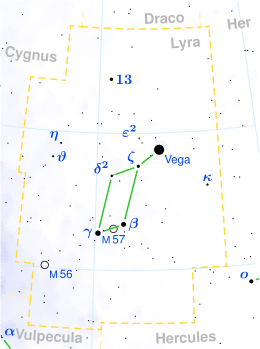Kappa Lyrae
κ Lyrae, Latinized as Kappa Lyrae, is a solitary[10] star in the northern constellation of Lyra, near the constellation border with Hercules. It is visible to the naked eye as a faint, orange-hued point of light with an apparent visual magnitude of 4.33.[2] This object is located approximately 238 light years from the Sun based on parallax,[1] but is moving closer with a radial velocity of −24 km/s.[6]
 | |
| Observation data Epoch J2000.0 Equinox J2000.0 | |
|---|---|
| Constellation | Lyra |
| Right ascension | 18h 19m 51.70908s[1] |
| Declination | +36° 03′ 52.3691″[1] |
| Apparent magnitude (V) | 4.33[2] |
| Characteristics | |
| Evolutionary stage | giant |
| Spectral type | K2-IIIabCN0.5[3] |
| U−B color index | +1.17[4] |
| B−V color index | +1.162±0.013[2] |
| Variable type | suspected[5] |
| Astrometry | |
| Radial velocity (Rv) | −24.36±0.13[6] km/s |
| Proper motion (μ) | RA: −16.75[1] mas/yr Dec.: +41.09[1] mas/yr |
| Parallax (π) | 13.71 ± 0.56[1] mas |
| Distance | 238 ± 10 ly (73 ± 3 pc) |
| Absolute magnitude (MV) | −0.11[2] |
| Details | |
| Radius | 18[6] R☉ |
| Luminosity | 127.4[7] L☉ |
| Surface gravity (log g) | 2.51[8] cgs |
| Temperature | 4,638[8] K |
| Metallicity [Fe/H] | +0.13[8] dex |
| Rotational velocity (v sin i) | 5.0[6] km/s |
| Other designations | |
| Database references | |
| SIMBAD | data |
This is an aging giant star with a stellar classification of K2-IIIabCN0.5,[3] with the suffix notation indicating a mild underabundance of cyanogen. Having exhausted the supply of hydrogen at its core, the star has cooled and expanded. It now has 18[6] times the Sun's girth and is radiating 127[7] times the luminosity of the Sun at an effective temperature of 4,638 K.[8] κ Lyrae is a red clump giant, which means it is on the horizontal branch and is generating energy through core helium fusion.[11] It is a suspected small amplitude variable star.[5]
References
- van Leeuwen, F. (2007), "Validation of the new Hipparcos reduction", Astronomy and Astrophysics, 474 (2): 653–664, arXiv:0708.1752, Bibcode:2007A&A...474..653V, doi:10.1051/0004-6361:20078357.
- Anderson, E.; Francis, Ch. (2012), "XHIP: An extended hipparcos compilation", Astronomy Letters, 38 (5): 331, arXiv:1108.4971, Bibcode:2012AstL...38..331A, doi:10.1134/S1063773712050015.
- Keenan, Philip C.; McNeil, Raymond C. (1989), "The Perkins catalog of revised MK types for the cooler stars", Astrophysical Journal Supplement Series, 71: 245, Bibcode:1989ApJS...71..245K, doi:10.1086/191373.
- Mermilliod, J.-C. (1986), "Compilation of Eggen's UBV data, transformed to UBV (unpublished)", Catalogue of Eggen's UBV Data. SIMBAD, Bibcode:1986EgUBV........0M.
- Percy, J. R.; et al. (1994), "Photometric surveys of suspected small-amplitude red variables. III: An AAVSO photometric photometry survey", Astronomical Society of the Pacific, 106 (700): 611–615, Bibcode:1994PASP..106..611P, doi:10.1086/133420.
- Massarotti, Alessandro; et al. (January 2008), "Rotational and radial velocities for a sample of 761 HIPPARCOS giants and the role of binarity", The Astronomical Journal, 135 (1): 209–231, Bibcode:2008AJ....135..209M, doi:10.1088/0004-6256/135/1/209.
- McDonald, I.; et al. (2012), "Fundamental Parameters and Infrared Excesses of Hipparcos Stars", Monthly Notices of the Royal Astronomical Society, 427 (1): 343–57, arXiv:1208.2037, Bibcode:2012MNRAS.427..343M, doi:10.1111/j.1365-2966.2012.21873.x.
- Maldonado, J.; et al. (June 2013), "The metallicity signature of evolved stars with planets", Astronomy & Astrophysics, 554: 18, arXiv:1303.3418, Bibcode:2013A&A...554A..84M, doi:10.1051/0004-6361/201321082, A84.
- "kap Lyr". SIMBAD. Centre de données astronomiques de Strasbourg. Retrieved October 14, 2007.
- Eggleton, P. P.; Tokovinin, A. A. (2008), "A catalogue of multiplicity among bright stellar systems", Monthly Notices of the Royal Astronomical Society, 389 (2): 869, arXiv:0806.2878, Bibcode:2008MNRAS.389..869E, doi:10.1111/j.1365-2966.2008.13596.x.
- Alves, David R. (August 2000), "K-Band Calibration of the Red Clump Luminosity", The Astrophysical Journal, 539 (2): 732–741, arXiv:astro-ph/0003329, Bibcode:2000ApJ...539..732A, doi:10.1086/309278.